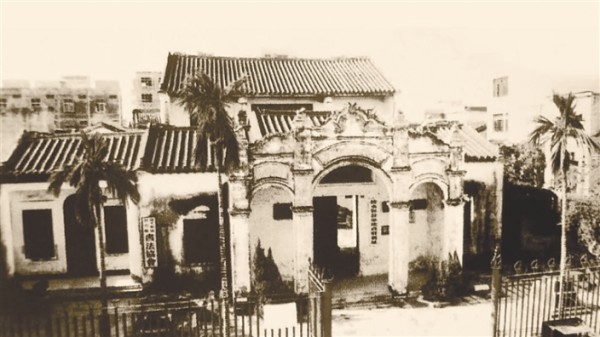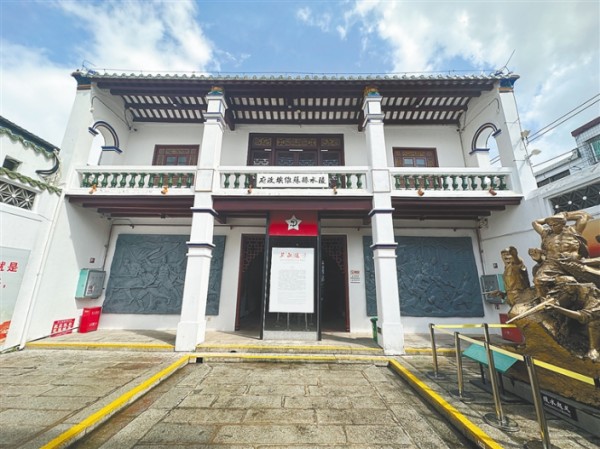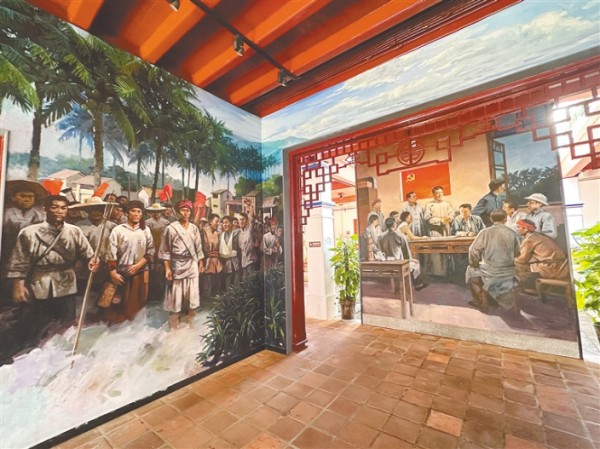Overseas Chinese Architecture in Hainan: Century-old Qiongshan Guild Hall
In Yelin Town, Lingshui, the Qiongshan Guild Hall stands serene amid the hustle and bustle of the city. Within the walls, a unique multi-courtyard structure combining Chinese and Western architectural styles draws the eye.

The entrance of the Qiongshan Guild Hall. (File Photo)
The Qiongshan Guild Hall has a rectangular footprint covering 760 square meters of construction area and occupying a total of 980 square meters of land. “The Qiongshan Guild Hall is laid out in the style of a Chinese multi-courtyard building, with Western architectural techniques employed in the exterior along with traditional Chinese doors and windows.” Chen Fenfei, director of the Lingshui Museum, explained that the wide variety of ornaments along the eaves and colorful porcelain ridge decorations common in south China in the post-Qing era are detailed but not ornate or overly lavish. Many of the other decorations and carvings on the building are also quite aesthetically pleasing.

A historic photo of the Qiongshan Guild Hall. (File Photo)
The historic Qiongshan Guild Hall building holds memories of two very different times, with echoes of the years of business guild meetings layered with reverberations of revolutionary storms, giving the structure unique cultural and historic significance.
The Business Era
One of the oldest, largest, and best preserved historic buildings in Lingshui, the Qiongshan Guild Hall was first built in 1921 by Fu Guangxian, a businessman from Qiongshan. The structure was funded by a group of Qiongshan locals who came to Lingshui to do business.
Guild Halls originated during the Ming and Qing Dynasties (1368-1912), and mainly functioned as places for colleagues and associates from the same hometown to gather, stay, and interact.
Lingshui has been an important hub of the Maritime Silk Road since ancient times. Merchant ships often stopped here to rest, and replenish supplies of fresh water, food, and goods. Over time, the area gained influence in the maritime trade between China and other nations. During the Ming and Qing Dynasties, Lingshui’s Tongqi Port served as a special port, a port where foreign envoys were received, ‘tribute trade’ was carried out, and Hainan businessmen exchanged goods with international merchants. Lingshui’s unique business environment provided fertile soil for local maritime merchant groups to form and grow.
“The Qiongshan Guild Hall was established mainly to assist Qiongshan businessmen in Lingshui in holding activities and meetings with each other,” explained Chen. The Guild Hall could coordinate business and industry, help people keep in touch with their hometowns, and also provide a place for old friends and travelers from Qionshan to stay short term. People came to the Hall for many reasons - to hold meetings and banquets, to honor important personages, assist people from their hometowns, and maintain connections with their origins.
Revolutionary Storms
Standing in peaceful silence amidst the clamor and clanging of the city, the Qiongshan Guild Hall holds another, very different past under her elegantly sloped roof. This is also the former site of the Lingshui County Soviet Government, the first county-level Chinese Soviet outpost in Hainan. (Translator’s note: The Chinese Soviet Republic was a Chinese state later founded on November 7, 1931 by CPC leaders such as Mao Zedong and Zhu De. It was the first democratic dictatorship of workers and peasants in Chinese history.)

Lingshui’s Qiongshan Guild Hall was the birthplace of the first county-level Chinese Soviet Government in Hainan. (Photo: Hainan Daily)
At the end of the 19th century, China suffered from both internal and external troubles. Faced with exploitation and oppression, all the peoples of Lingshui gathered together to fight through the darkness of the night.
In 1927, under the Communist leadership of Huang Zhenshi, the peoples of Lingshui united as an armed force comprised mainly of the local Li people. Together, they launched three armed uprisings and established the first county-level Chinese Soviet government in Hainan - the Lingshui County Soviet Government.

An exhibition in the Hall illustrates the Soviet revolutionary struggle in Lingshui County. (Photo: Hainan Daily)
“At that time, over 10 village heads led armed forces to join the revolution, swelling the peasant army of Lingshui to seven or eight hundred fighters in total. Since there were many Li people in the ranks, the ox horns they carried served as military bugles.” Chen pointed to the display window, which holds a collection of historic artifacts from the period.
The former site of the Lingshui County Soviet Government is listed as a national key cultural relic protection site by the State Council. Visitors can trace the revolutionary footsteps of those who gathered here, and commemorate the achievements of the area’s martyrs.